Dielectrophoresis Separation of Platelets Using a Novel Zigzag Microchannel
Abstract
1. Introduction
2. Materials and Methods
2.1. Dielectrophoresis Theory
2.2. Initial and Boundary Conditions
2.3. Fabrication of the Microfluidic Chip
2.4. Materials and Experimental Setup
3. Results and Discussion
3.1. Structural Parameters and Analysis of Influential Parameters
3.1.1. Influence of Corner Angles
3.1.2. Influence of Channel Width and Length
3.1.3. Influence of the Velocity Ratio
3.1.4. Influence of Driving Voltage
3.1.5. Influence of Driving Frequency
3.1.6. Influence of Cell Size
3.2. Experimental Analysis of Platelet Separation Efficiency
4. Conclusions
Author Contributions
Funding
Acknowledgments
Conflicts of Interest
References
- Lee, J.; Rhyou, C.; Kang, B.; Lee, H. Continuously Phase-Modulated Standing Surface Acoustic Waves for Separation of Particles and Cells in Microfluidic Channels Containing Multiple Pressure Nodes. J. Phys. D Appl. Phys. 2016, 50, 165401. [Google Scholar] [CrossRef]
- Antfolk, M.; Laurell, T.; Antfolk, M.; Laurell, T. Continuous flow microfluidic separation and processing of rare cells and bioparticles found in blood—A review. Anal. Chem. Acta 2017, 965, 9–35. [Google Scholar] [CrossRef]
- Imhof, H.K.; Schmid, J.; Niessner, R.; Ivleva, N.P.; Laforsch, C. A novel highly efficient method for the separation and quantification of plastic particles in sediments of aquatic environments. Limnol. Oceanogr. Methods 2012, 10, 524–537. [Google Scholar] [CrossRef]
- Spieler, V.; Valldorf, B.; Spieler, F.; Valldorf, V.; Maaß, B.; Hüttenhain, S.H.; Kolmar, K. Coupled reactions on bioparticles: Stereoselective reduction with cofactor regeneration on PhaC inclusion bodies. Biotechnol. J. 2016, 11, 890–898. [Google Scholar] [CrossRef] [PubMed]
- Islinger, M.; Wildgruber, R.; Voelkl, A. Preparative free-flow electrophoresis, a versatile technology complementing gradient centrifugation in the isolation of highly purified cell organelles. Electrophoresis 2018, 39, 2288–2299. [Google Scholar] [CrossRef] [PubMed]
- Sorsa, T.; Gieselmann, D.; Arweiler, N.B.; Hernández, M. A quantitative point-of-care test for periodontal and dental peri-implant diseases. Nat. Rev. Dis. Primers 2017, 3, 17069. [Google Scholar] [CrossRef] [PubMed]
- Gish, R.G.; Gutierrez, J.A.; Navarro-Cazarez, N.; Giang, K.; Adler, D.; Tran, B.; Locarnini, S.; Hammond, R.; Bowden, S. A simple and inexpensive point-of-care test for hepatitis B surface antigen detection: Serological and molecular evaluation. J. Viral Hepat. 2014, 21, 905–908. [Google Scholar] [CrossRef]
- Syverud, B.C.; Lin, E.; Nagrath, S.; Larkin, L.M. Label-Free, High-Throughput Purification of Satellite Cells Using Microfluidic Inertial Separation. Tissue Eng. Part C Methods 2018, 24, 32–41. [Google Scholar] [CrossRef]
- Hisey, C.L.; Dorayappan, K.D.P.; Cohn, D.E.; Karuppaiyah, S.; Hansford, D.J. Microfluidic Affinity Separation Chip for Selective Capture and Release of Label-free Ovarian Cancer Exosomes. Lab Chip 2018, 18, 15. [Google Scholar] [CrossRef]
- Ahmad, I.L.; Ahmad, M.R.; Takeuchi, M.; Nakajima, M.; Hasegawa, Y. Tapered Microfluidic for Continuous Micro-Object Separation Based on Hydrodynamic Principle. IEEE Trans. Biomed. Circuits Syst. 2017, 11, 1413–1421. [Google Scholar] [CrossRef]
- Shamloo, A.; Boodaghi, M. Design and simulation of a microfluidic device for acoustic cell separation. Ultrasonics 2018, 84, 234–243. [Google Scholar] [CrossRef] [PubMed]
- Savage, W.J.; Burns, J.R.; Fiering, J. Safety of acoustic separation in plastic devices for extracorporeal blood processing. Transfusion 2017, 57, 1818–1826. [Google Scholar] [CrossRef] [PubMed]
- Wu, T.H.; Chen, Y.; Park, S.Y.; Hong, J.; Teslaa, T.; Zhong, J.F.; Carlo, D.D.; Teitell, M.A.; Chiou, P.Y. Pulsed laser triggered high speed microfluidic fluorescence activated cell sorter. Lab Chip 2012, 12, 1378–1383. [Google Scholar] [CrossRef] [PubMed]
- Rosental, B.; Kozhekbaeva, Z.; Fernhoff, N.; Tsai, J.M.; Traylor-Knowles, N. Coral cell separation and isolation by fluorescence-activated cell sorting (FACS). BMC Cell Biol. 2017, 18, 30. [Google Scholar] [CrossRef] [PubMed]
- Tamura, M.; Sugiura, S.; Takagi, T.; Satoh, T.; Sumaru, K.; Kanamori, T.; Okada, T.; Matsui, H. Morphology-based optical separation of subpopulations from a heterogeneous murine breast cancer cell line. PLoS ONE 2017, 12, e0179372. [Google Scholar] [CrossRef]
- Strokin, N.A.; Bardakov, V.M. Development of Idea of Plasma-Optical Mass Separation. Plasma Phys. Rep. 2019, 45, 46–56. [Google Scholar] [CrossRef]
- Pamme, N.; Wilhelm, C. Continuous sorting of magnetic cells via on-chip free-flflow magnetophoresis. Lab Chip 2006, 6, 974–980. [Google Scholar] [CrossRef]
- Oh, S.; Jung, S.H.; Seo, H.; Min, M.-K.; Kim, B.; Hahn, Y.K.; Kang, J.H.; Choi, S. Magnetic activated cell sorting (MACS) pipette tip for immunomagnetic bacteria separation. Sens. Actuators B Chem. 2018, 272, 324–330. [Google Scholar] [CrossRef]
- Bayati, P.; Najafi, A. Electrophoresis of active Janus particles. J. Chem. Phys. 2019, 150, 234902. [Google Scholar] [CrossRef]
- Maurya, S.K.; Gopmandal, P.P.; Ohshima, H. Electrophoresis of concentrated suspension of soft particles with volumetrically charged inner core. Colloid Polym. Sci. 2018, 296, 721–732. [Google Scholar] [CrossRef]
- Lin, C.-C.; Ho, Y.-H.; Yang, Y.-M.; Chang, H.-C. Combing Reman scattering technique with dielectrophoresis chip for clinical isolates Helicobacter pylori analysis. In Proceedings of the 2008 3rd IEEE International Conference on Nano/Micro Engineered and Molecular Systems, Sanya, China, 6–9 January 2008. [Google Scholar]
- Pohl, H.A.; Pohl, H.A. Dielectrophosis: The Behavior of Neutral Matter in Nonuniform Electric Fields. Q. Rev. Biol. 1980, 55, 6–69. [Google Scholar]
- Pething, R. Dielectrophoresis: Status of the theory, technology, and applications. Biomicrofluidics 2010, 4, 022811. [Google Scholar] [CrossRef] [PubMed]
- Huang, Y. Dielectrophoretic cell separation and gene expression profifiling on microelectronic chip arrays. Anal. Chem. 2002, 74, 3362–3371. [Google Scholar] [CrossRef]
- Rahmani, A.; Mohammadi, A.; Kalhor, H.R. A continuous flow microfluidic device based on contactless dielectrophoresis for bioparticles enrichment. Electrophoresis 2017, 39, 445–455. [Google Scholar] [CrossRef]
- Liao, S.-H.; Chang, H.-C.; Chang, H.-C. A capillary dielectrophoretic chip for real-time blood cell separation from a drop of whole blood. Biomicrofluidics 2013, 7, 024110. [Google Scholar] [CrossRef] [PubMed]
- Stroncek, D.F.; Rebulla, P. Platelet transfusions. Lancet 2007, 370, 427–438. [Google Scholar] [CrossRef]
- Pommer, M.S.; Zhang, Y.; Keerthi, N.; Chen, N.; Thomson, J.A.; Meinhart, C.D.; Soh, H.T. Dielectrophoretic separation of platelets from diluted whole blood in microfluidic channels. Electrophoresis 2008, 29, 1213–1218. [Google Scholar] [CrossRef]
- Piacentini, N.; Mernier, G.; Tornay, R.; Renaud, P. Separation of platelets from other blood cells in continuous-flow by dielectrophoresis field-flow-fractionation. Biomicrofluidics 2011, 5, 034122. [Google Scholar] [CrossRef]
- Oblak, J.; Krizaj, D.; Amon, S.; Lebar, A.M.; Miklavčič, D. Feasibility study for cell electroporation detection and separation by means of dielectrophoresis. Bioelectrochemistry 2007, 71, 164–17171. [Google Scholar] [CrossRef]
- Shwetha, M.; Narayan, K. Mach-Zehnder interferometer for separation of platelets from red blood cells using dielectrophoretics. Am. Inst. Phys. 2016, 1715, 020068. [Google Scholar]
- Zhang, J.; Yan, S.; Sluyter, R.; Li, W.; Alici, G.; Nguyen, N.-T. Inertial particle separation by differential equilibrium positions in a symmetrical serpentine micro-channel. Sci. Rep. 2014, 4, 4527. [Google Scholar] [CrossRef] [PubMed]
- Di Carlo, D. Inertial microfluidics. Lab Chip 2009, 9, 3038–3046. [Google Scholar] [CrossRef] [PubMed]
- Zhang, J.; Yan, S.; Yuan, D.; Alici, G.; Nguyen, N.-T.; Ebrahimi Warkiani, E.; Li, W. Fundamentals and applications of inertial microfluidics: A review. Lab Chip 2016, 16, 10–34. [Google Scholar] [CrossRef]
- Feng, Q.L. Continuous Cells Manipulation and Separation Chip Using Dielectrophoresis Technology. Master’s Thesis, Taiyuan University of Technology, Taiyuan, China, 2016. [Google Scholar]
- Chen, J.K.; Yang, R.J. Electroosmotic flow mixing in zigzag microchannels. Vacuum 2012, 86, 1778–1782. [Google Scholar] [CrossRef] [PubMed]
- Qiang, Y.; Liu, J.; Yang, F.; Dieujuste, D.; Du, E. Modeling erythrocyte electrodeformation in response to amplitude modulated electric waveforms. Sci. Rep. 2018, 8, 10224. [Google Scholar] [CrossRef] [PubMed]
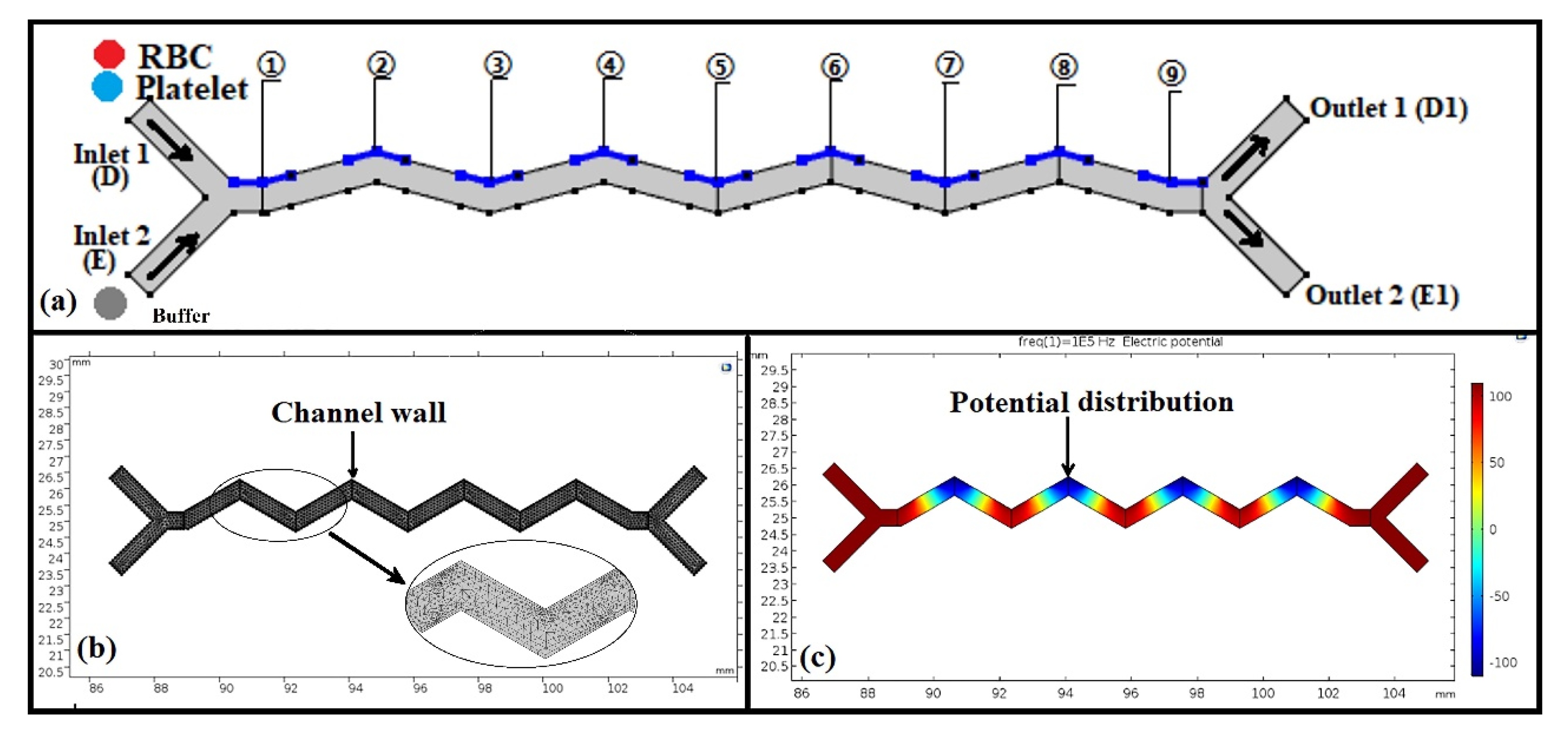
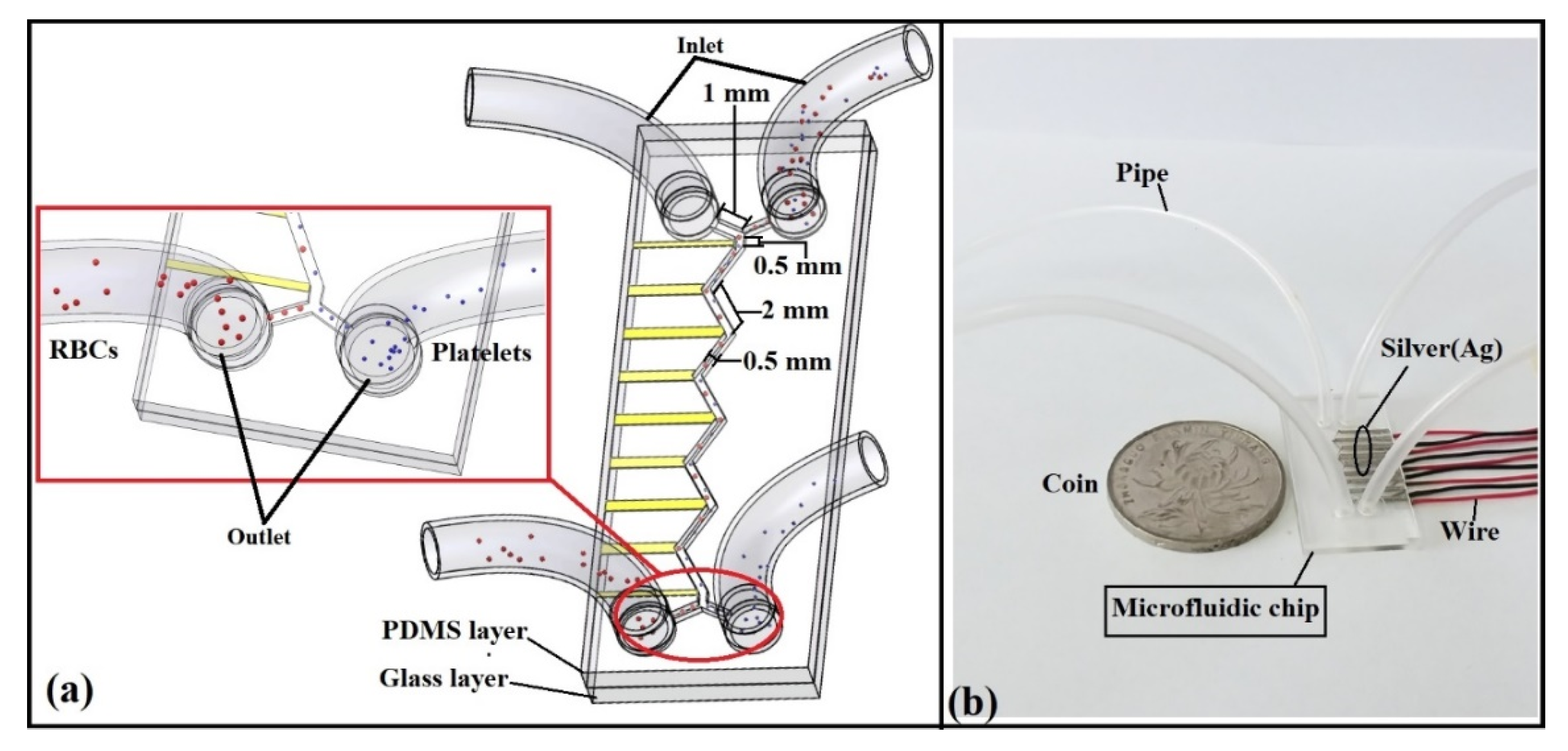
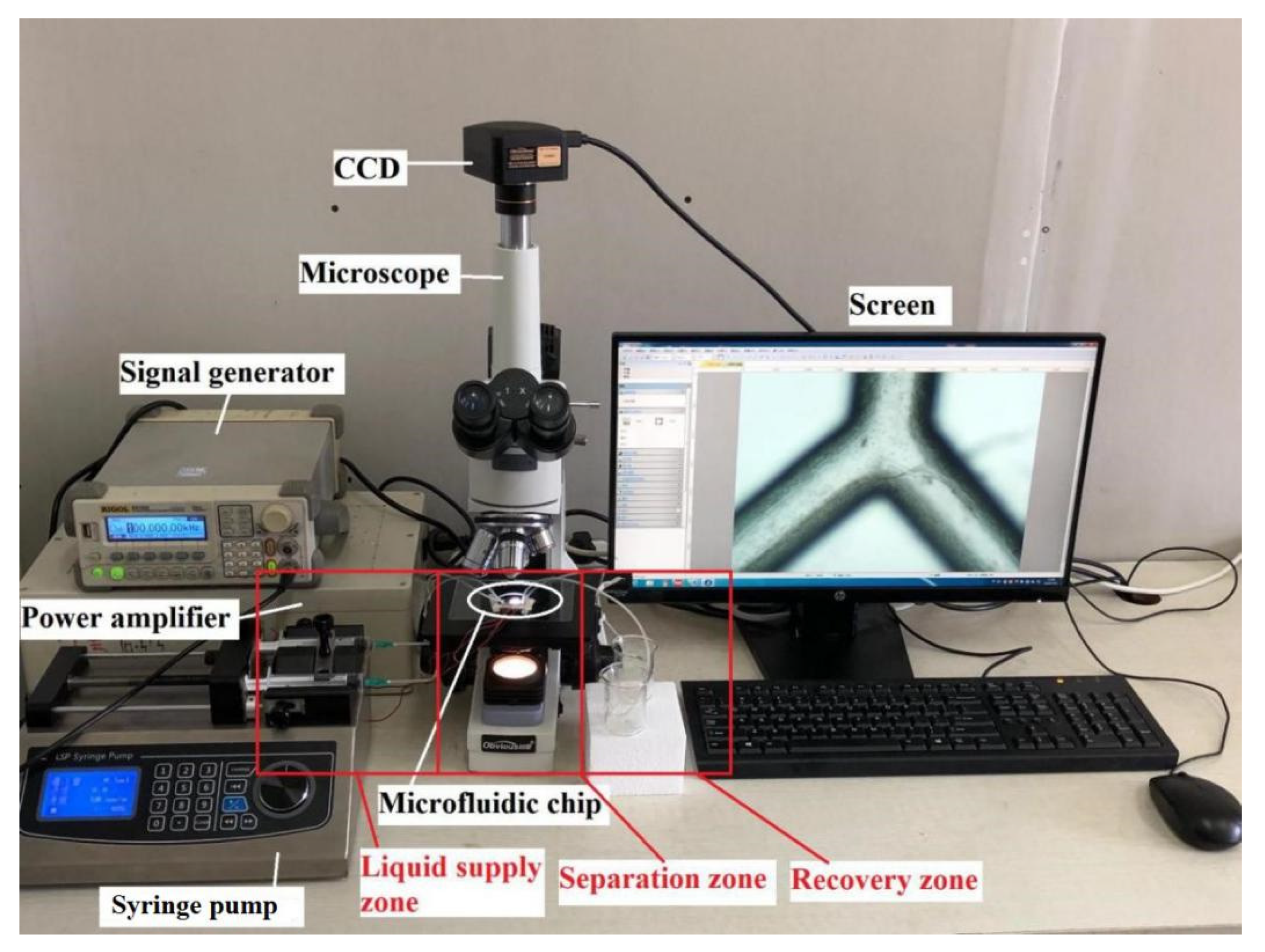

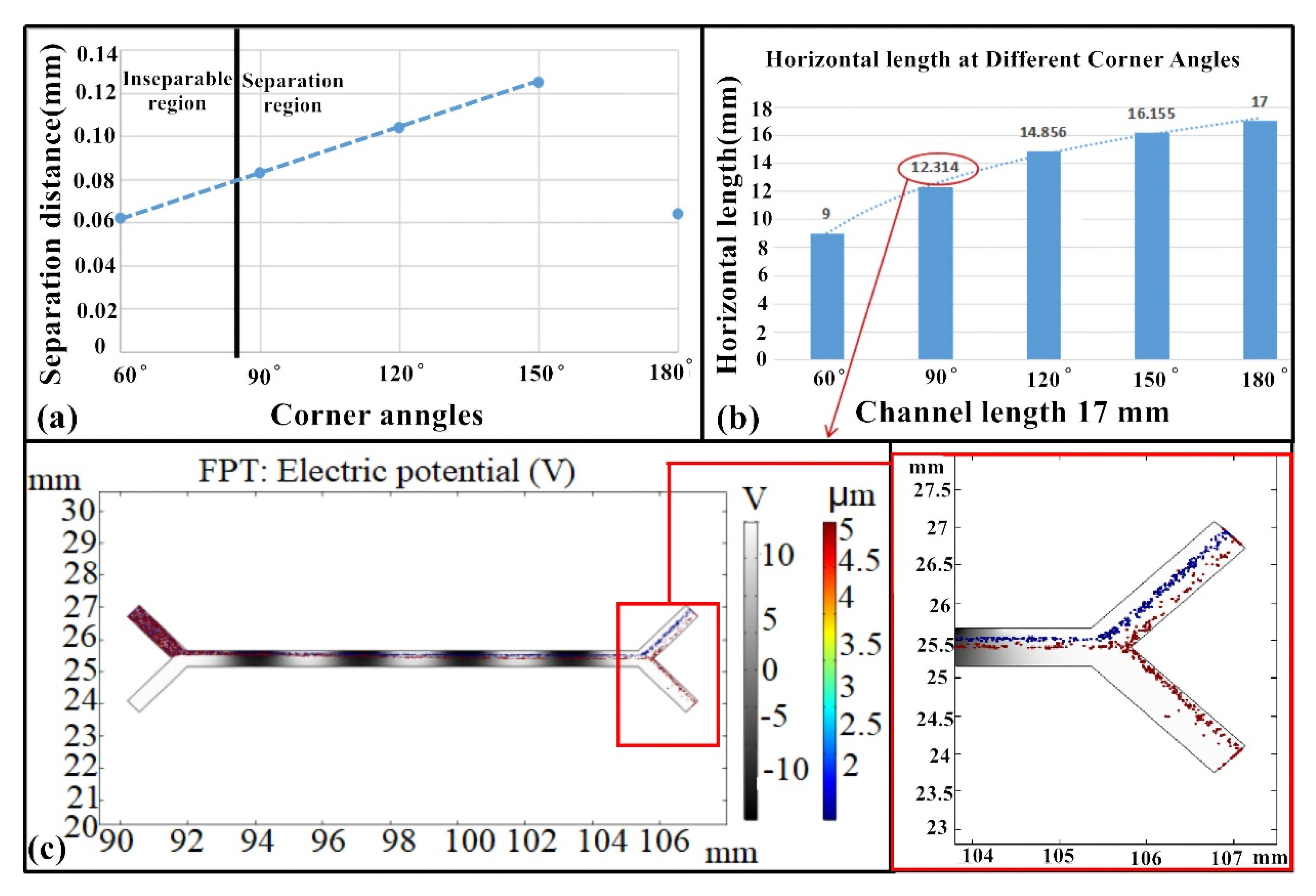
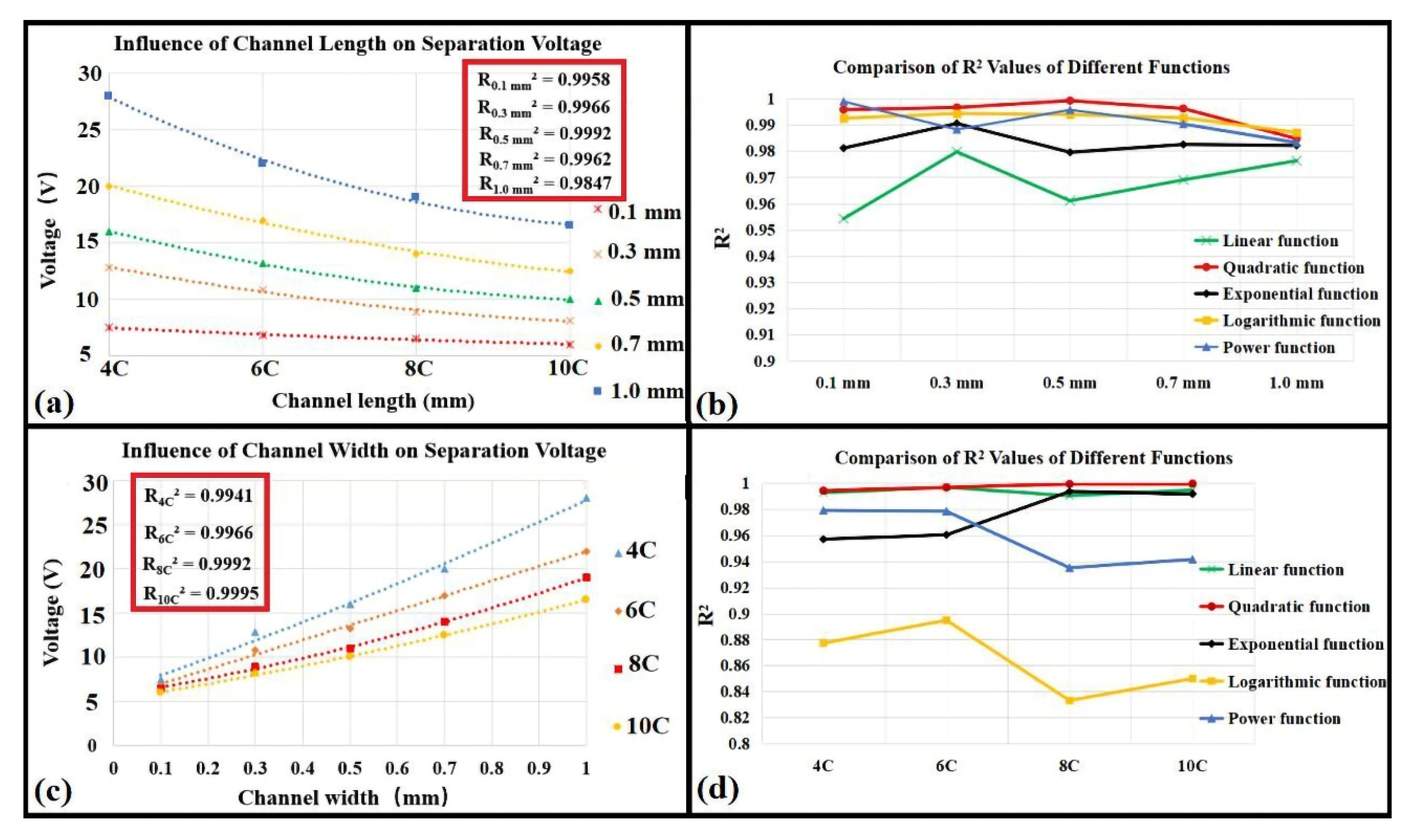
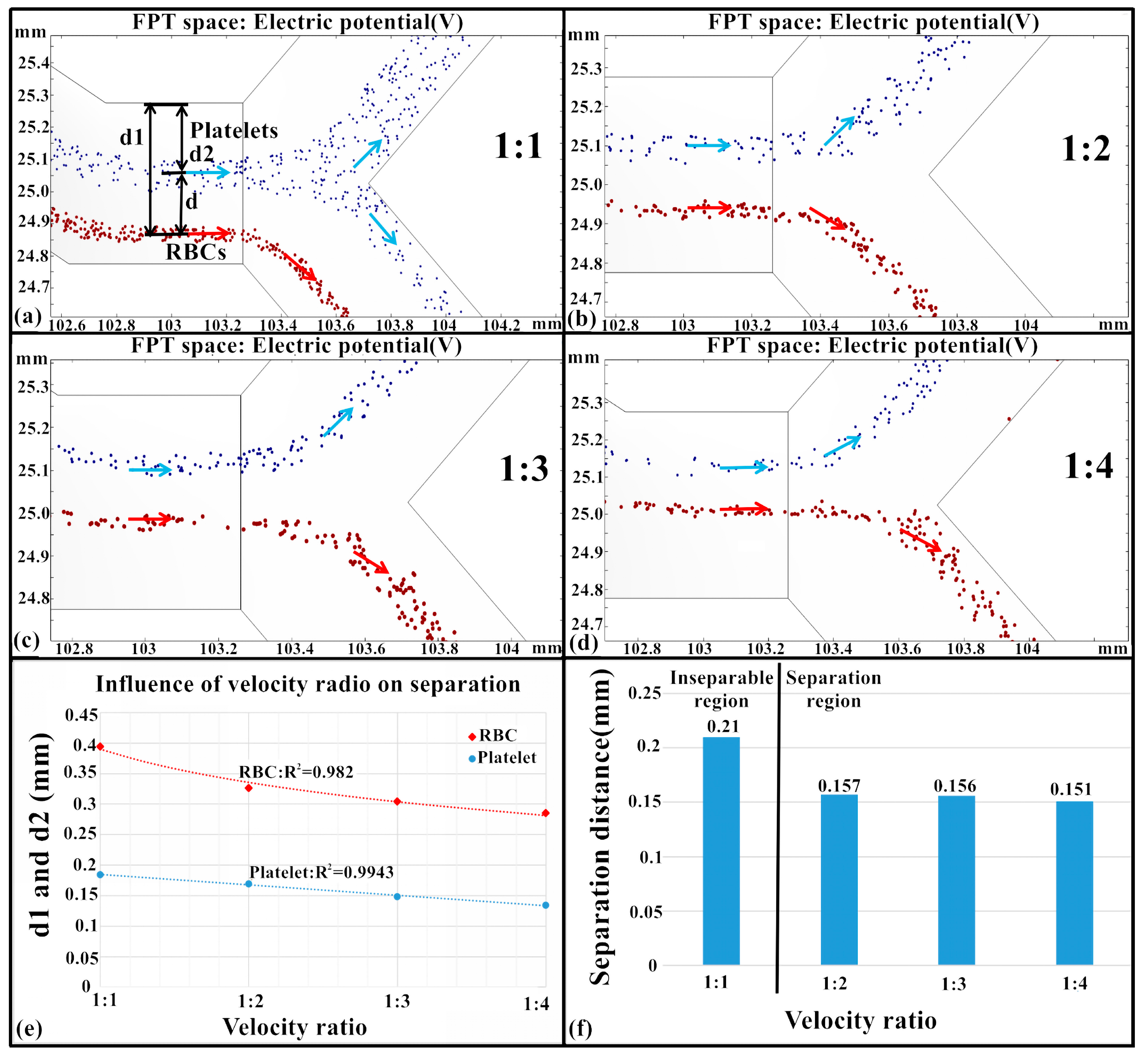
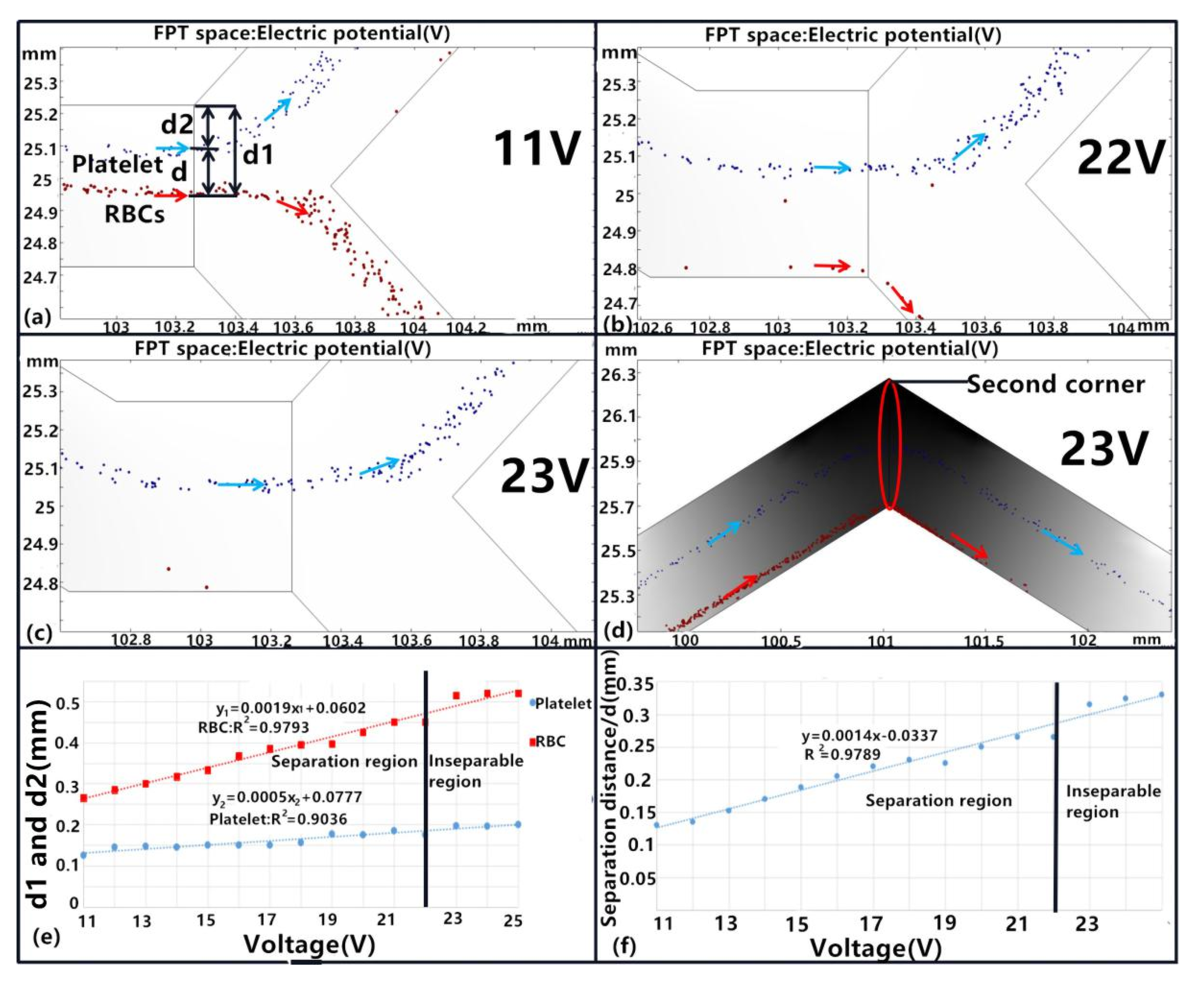
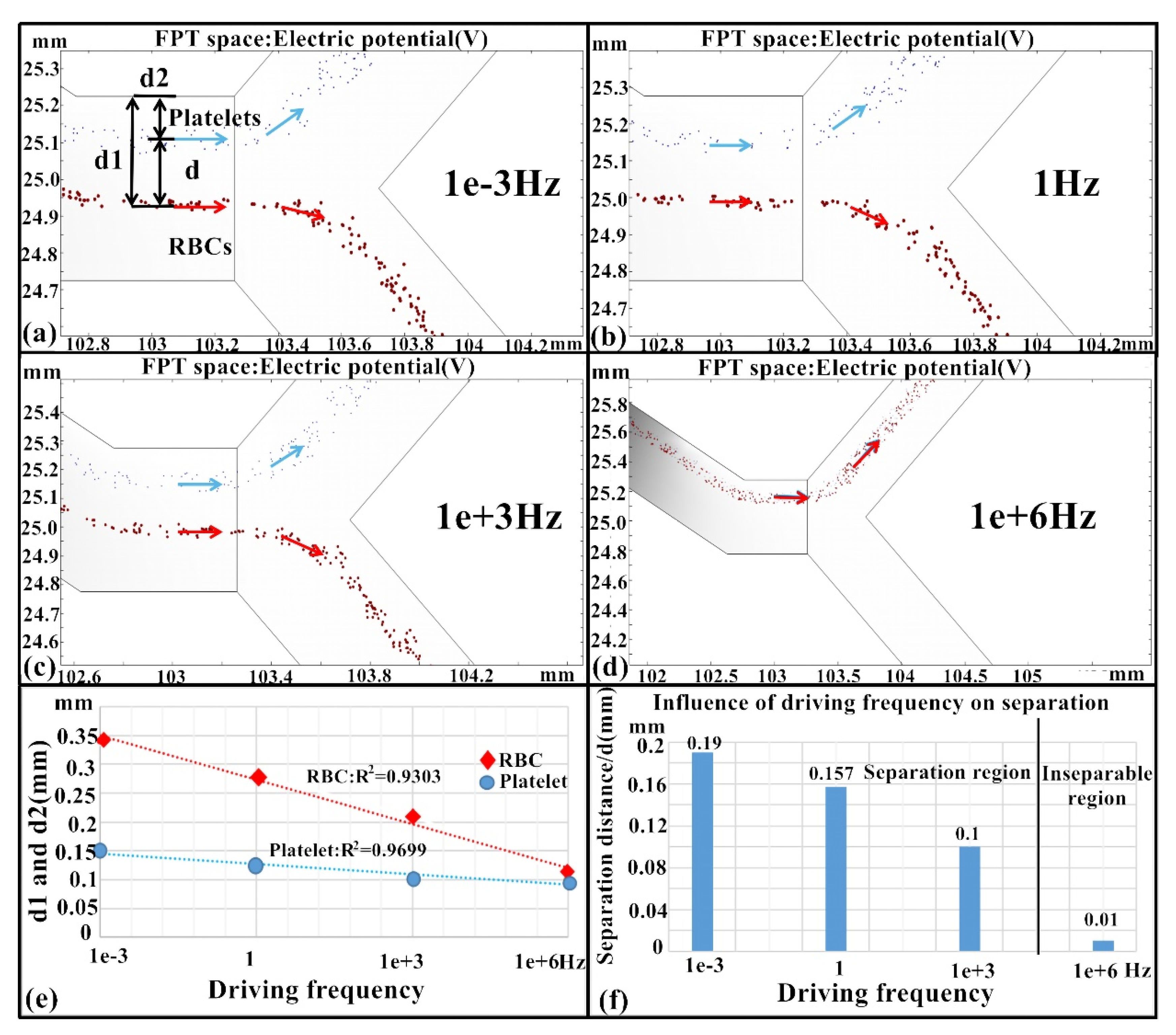

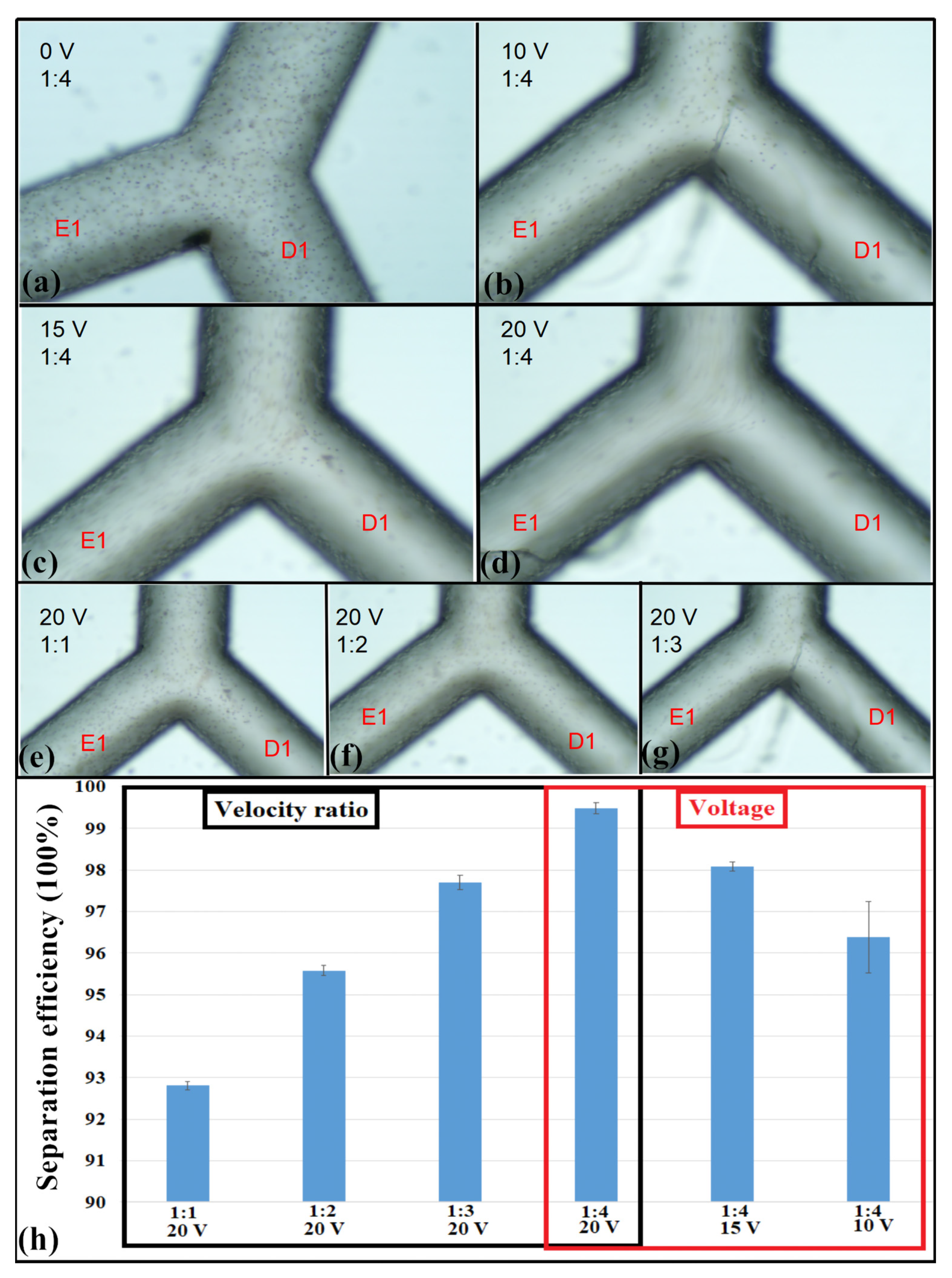
© 2020 by the authors. Licensee MDPI, Basel, Switzerland. This article is an open access article distributed under the terms and conditions of the Creative Commons Attribution (CC BY) license (http://creativecommons.org/licenses/by/4.0/).
Share and Cite
Guan, Y.; Liu, Y.; Lei, H.; Liu, S.; Xu, F.; Meng, X.; Bai, M.; Wang, X.; Yang, G. Dielectrophoresis Separation of Platelets Using a Novel Zigzag Microchannel. Micromachines 2020, 11, 890. https://doi.org/10.3390/mi11100890
Guan Y, Liu Y, Lei H, Liu S, Xu F, Meng X, Bai M, Wang X, Yang G. Dielectrophoresis Separation of Platelets Using a Novel Zigzag Microchannel. Micromachines. 2020; 11(10):890. https://doi.org/10.3390/mi11100890
Chicago/Turabian StyleGuan, Yanfang, Yansheng Liu, Hui Lei, Shihua Liu, Fengqian Xu, Xiangxin Meng, Mingyang Bai, Xiaoliang Wang, and Gexuan Yang. 2020. "Dielectrophoresis Separation of Platelets Using a Novel Zigzag Microchannel" Micromachines 11, no. 10: 890. https://doi.org/10.3390/mi11100890
APA StyleGuan, Y., Liu, Y., Lei, H., Liu, S., Xu, F., Meng, X., Bai, M., Wang, X., & Yang, G. (2020). Dielectrophoresis Separation of Platelets Using a Novel Zigzag Microchannel. Micromachines, 11(10), 890. https://doi.org/10.3390/mi11100890




